Where to go in Switzerland on a short trip: Alps, lakes, and cities
Switzerland is an extremely popular country for those planning multi-stop tours around Europe, yet very few potential first-time visitors actually know specifically where they want to go. Everyone seems to know that it has the most beautiful views of the Alps and some very impressive cities, but there are actually many misconceptions among casual trip planners, so I’d like to clear most of that up below. The places to visit in Switzerland are not obvious until you’ve been there yourself or done many hours of research, so the list below should be a short cut.
I get hundreds if not thousands of itinerary questions for people who are considering a Eurail trip around Europe, and most people just include the word “Switzerland” among a list of cities like Paris, Rome, and Berlin that they want to visit. So where in Switzerland should you go if you can only make a few stops at most? I’ll answer that question below.
Note: This article was expanded and updated in February, 2024.
Switzerland is about outdoor views rather than city visits
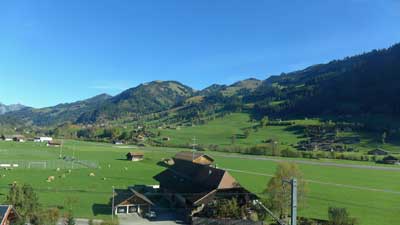
Geneva is a very famous city (though not for tourism reasons) on a lovely lake of the same name, but it’s also notoriously dull and lacking distinction. Rick Steves puts it well by saying that “Geneva is pleasantly situated on a lake, like Buffalo or Cleveland.” The point is, you don’t want to go to Geneva unless you’ve got something specific in mind that you want to see there.
Switzerland's cities in summary
Zurich – The largest city, very expensive, geared towards business travelers. It’s generally a pretty and very well-run city that you would enjoy if you visited, but it’s not nearly as interesting as the likes of Vienna, Munich, or of course Paris.
Geneva – Second largest city, in the French part of the country, no major sights. Again, if you visited you’d be very impressed by it and get some great photos, but it’s not worth your time unless you know someone there. There’s an impressive fountain in the lake and you can usually see it from the train as you go through the city, but it’s not really worth going there and staying more than an hour or so.
Basel – Bordering France and Germany, no major sights. It has the famous art market each year, and aside from that it’s even duller than the ones above. Again, if you visited you’d be impressed, but if you later compared photos with friends who went to the Lauterbrunnen Valley instead, you’d kick yourself for going to Basel.
Lausanne – Near Geneva in the French part of the country, very hilly, and certainly more interesting than Geneva.
Bern – The capital, compact, on a lovely river, some interesting sights and the best Swiss city to get a feel for the culture. Bern is fairly close to Interlaken (which we will discuss below) and it can be a great day trip from there, especially on a day where it is foggy and/or rainy in the mountains (and this happens a LOT).
How much time and which Swiss cities to visit?
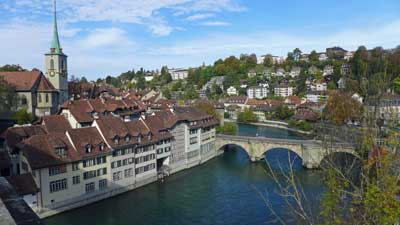
Many people (me included) don’t feel as if they’ve scratched the surface of a new country if they haven’t spent at least a day or two in the largest city. Zurich is certainly pleasant and a useful transit hub so spending one or two nights there wouldn’t be a major mistake. But Zurich isn’t even close to being a city like Paris, Rome, Berlin, Amsterdam, or even Vienna. If you skip it in favor of spending more time in the outdoors, you won’t be missing much.
The 2 Swiss places to focus on for short visits
Interlaken – If you want the best possible Alpine views and activities, head to the Interlaken area, which will be described in detail below.
Lucerne – The traditional Swiss tourist retreat, Lucerne is a small city with interesting culture and sights, that is gorgeously set on a lake with plenty of top activities surrounding it.
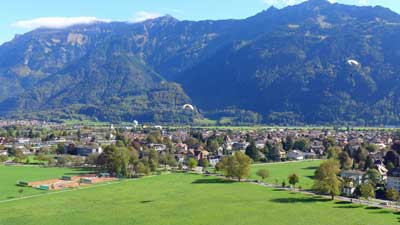
>>>Interlaken and Lucerne: Which to choose and how long to stay in each?
The article linked above will give you more details on which to choose and how long to spend in each place.
What about Zermatt for Alpine views?
Zermatt is a remote car-free village in southern Switzerland that is famous for being the place to see the Matterhorn mountain. It’s also a busy ski resort area, and aside from that, there isn’t much to see or do here. It’s on a private rail line, so it’s more complicated and usually more expensive to reach than Interlaken.
In other words, unless you’ve irrationally placed “Seeing the Matterhorn in person” on your so-called bucket list, skip Zermatt and head to Interlaken on a shorter visit. You won’t be sorry. If you already have enough time in your visit for the main sights around Interlaken and Lucerne and you want to also see the Matterhorn, then by all means go and you’ll enjoy it. There are quite a few other car-free villages in the Lauterbrunnen Valley near Interlaken, so they are not as novel in Switzerland as one might expect.
A weekend in Switzerland?
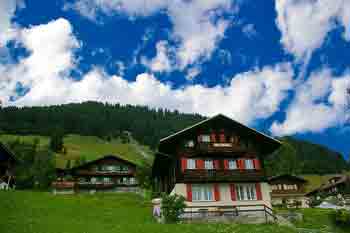
One challenge is that neither has an international airport so you’ll either be flying into Zurich or perhaps Geneva.
Train times from Zurich to Lucerne to Interlaken and back
- Zurich Airport to Lucerne: 1 hour 10 minutes by train
- Lucerne to Interlaken: 2 hours by train
- Interlaken to Zurich Airport: 2 hours 15 minutes by train
As you can see with the travel times above, Zurich Airport to Lucerne is a fairly short trip, but once you add Interlaken into the mix (even if you skip Lucerne) the travel time starts to add up for a weekend visit. With this in mind it’s probably best to just choose one of them and save the other one for another trip.
Lucerne is gorgeous, but the Lauterbrunnen Valley near Interlaken is really the star of the show, so I’d recommend going there first and doing Lucerne on another trip.
What about the Swiss Travel Pass?
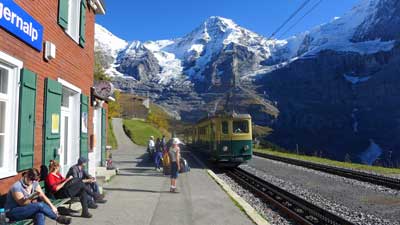
The bottom line is that if you are coming to Switzerland for at least 3 days and you want to take 2 or more of the amazing scenic rail journeys that the country is famous for, the travel pass is probably a good deal. It also provides 50% discounts on the Schilthorn cable car and 25% off the Jungfraujoch mountain railway. Both of those are quite expensive on their own, but extremely worthwhile, so the discount is helpful.
The Half Fare Card is probably a better deal for most people
The Swiss Travel Pass is a good deal for those who are going to be spending at least 2 or 3 days riding the rails and seeing Switzerland that way. But if you are mostly going to be focusing on Interlaken and Lucerne and the mountain sights, the Half Fare Card is the best option. For CHF120 (about US$134) you get the card that is good for 30 days and gives you a 50% discount on all trains, cable cars, mountain railways, and other sights and attractions. If you are doing either Schilthorn or Jungfraujoch, the Half Fare Card practically pays for itself with just one of those.
>>>Buy the Swiss Half Fare Card
Many people have questions about the Swiss Half Fare Card so I will explain it a bit here. You can actually buy half price train tickets for travel within Switzerland any time you want and you will see that option when you go to buy them online. The only thing is you have to have and present a valid Half Fare Card when you get on the train and are asked to see your ticket. In other words, you can buy a half fare train ticket today and buy a Half Fare Card just before you get on that train months in the future, and you are fine.
How and why visit the area around Interlaken
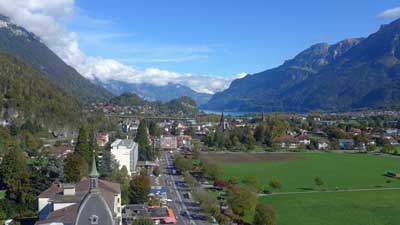
You can see everything discussed below by actually staying in a hotel in Interlaken, but it’s not the Alpine experience that you get if you stay in one of the small villages nearby. You can reach those villages in 20 to 40 minutes from the Interlaken Ost (East) train station, and it’s much easier than it sounds.
The 3 best places to stay to visit the Swiss Alps
Lauterbrunnen – A private train line runs from Interlaken Ost station to the end of its line in Lauterbrunnen. There’s a lovely waterfall here and great hiking trails, but you should probably only stay here if you can’t get to one of the villages mentioned just below. It’s a great little transit hub and it’s definitely gorgeous, so it can be worth a night if you’ve got one to spare.
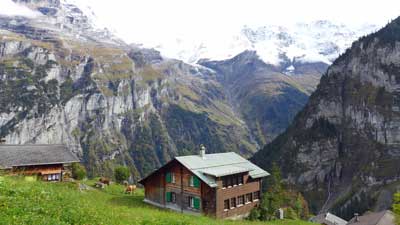
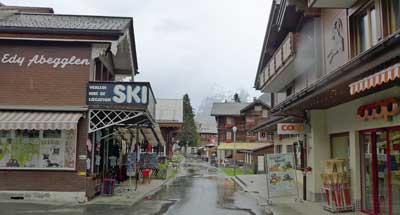
Where to stay in Interlaken and the Lauterbrunnen Valley (with pics)
I get so many questions about where to stay in the Interlaken area that I decided to write a longer version of it and load it with huge photos so readers can get a better feel for each option. I also included recommendations for affordable and well-located photos in each area.
>>>Where to stay in Interlaken and the Lauterbrunnen Valley New for 2024!
The unforgettable things to see here (if the weather is decent)
Schilthorn observation deck and restaurant
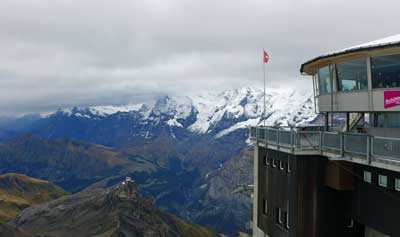
There is a rotating restaurant (with prices similar to normal Swiss restaurants) and a bizarre and anachronistic James Bond attraction based on it being a key location in the 1969 movie On Her Majesty’s Secret Service. The Bond thing is included with the lift, and it’s worth a look.
But the main thing you come here for is the 360-degree view from one of the highest peaks in Europe. Again, the weather here is key, but fortunately all the locals track the visibility on a minute-by-minute basis. If it’s clear up top while you are in the area, it would be a terrible shame to skip it based on the high price. But even if it’s cloudy up top, there are still plenty of wonderful things to see and do in the villages below.
Jungfraujoch observation area
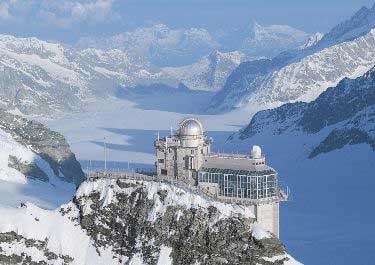
The views from the top are similar to the views from Schilthorn, from the other side of the Lauterbrunnen Valley. Once on top you can have lunch, hike, or even go sledding. It’s also quite expensive at nearly US$200 round-trip unless you have a Swiss Pass or a Eurail Pass for discounts, and it takes most of your day, but you’ll never forget the views from the top.
Harder Kulm mountain and Two Lakes Bridge Observation Deck
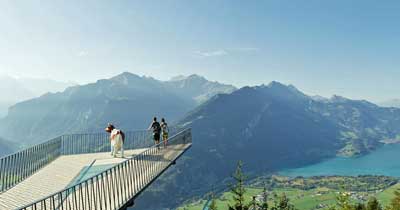
There’s a revolving restaurant about 10 minutes’ walk from the station at the top, which is definitely an unforgettable place for lunch if you’ve got time. It’s not as expensive as you might expect, at least compared to normal restaurants in Switzerland.
The Harder Kulm Railway goes from early April through late November each year. If you are only in Interlaken for one day and/or you are on a strict budget, this is the fastest and best way to get amazing Alpine views in the area.
Getting from Interlaken to Gimmelwald and Mürren
Getting up to these villages sounds complicated and time consuming, but it’s actually fast and easy once you get there. This little guide should help.
Arrive in Interlaken
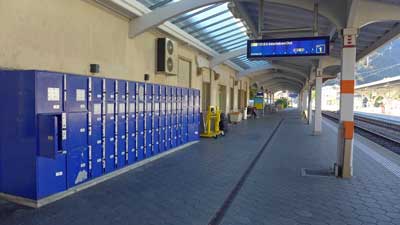
Once you arrive at the Interlaken Ost train station, head for the ticket windows in the office and buy a ticket to your final destination (Lauterbrunnen, Gimmelwald, or Mürren). Eurail passes are good for 25% discounts on the rest of the trip, but not for the whole thing.
From Interlaken Ost to Lauterbrunnen
The private train leaves Interlaken Ost every 30 minutes and arrives in Lauterbrunnen 20 minutes later. If you are staying in Lauterbrunnen then you are probably walking distance from your hotel when you reach the station.
From Lauterbrunnen to Gimmelwald
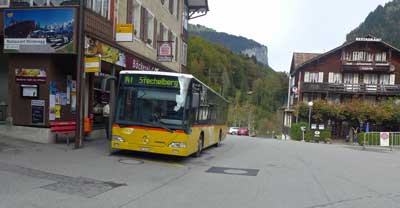
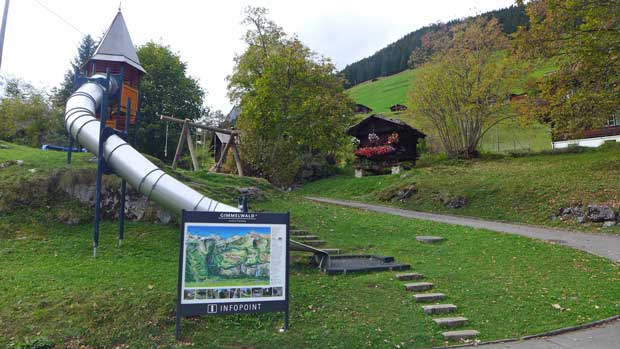
From
Gimmelwald to Mürren
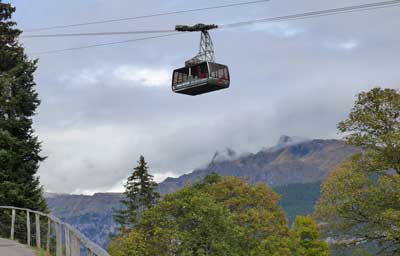
Recommended hotel and hostel in Gimmelwald
I get asked all the time about where to stay in Gimmelwald, so here it is:
Hotel: Esther’s Guesthouse
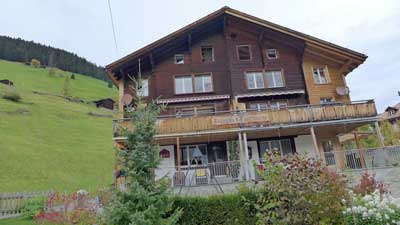
It’s run by Esther, as you might guess, and she is very friendly speaking excellent English. Each room is different and the place feels like a mountain cabin, because it is. She offers an excellent buffet breakfast in the morning, which you have to order the night before. It’s not cheap, but it’s worth it because it’s hearty and there are no other good options nearby.
Book as early as possible because this place is often the first place to sell out in Gimmelwald.
Hostel: Mountain Hostel Gimmelwald
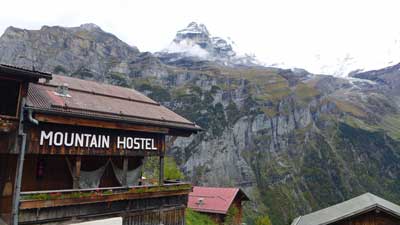
You won’t believe the views from this place, which are the same as from Esther’s except a bit lower and more unobstructed. This place also has a busy bar and restaurant that is basically the only “nightlife” in Gimmelwald. Many hikers get to bed early in this tiny village, but if you want to have a couple drinks and order a pizza or some local options, this is the place to go.
Again, book early because this place is always sold out.
Lucerne and what to do there
Luzern, as it’s spelled locally, is the other traditional holiday destination in Switzerland. Unlike Interlaken, Lucerne actually qualifies as a small city rather than a small resort town, so it’s a very nice contrast and very worthwhile.
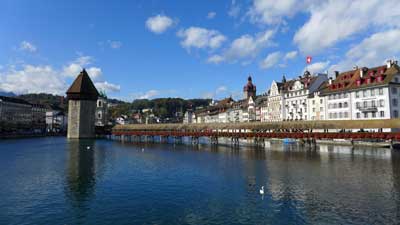
However, unlike Interlaken, the town of Lucerne itself is a great attraction and worth at least a day of exploration. This has always been a rich area so you can expect to find all of the high-end shops and boutiques along the small streets just north of the lake, but there are also many traditional shops and things to see that will appeal to anyone.
Recommended hotel in Lucerne
>>Hotel Des Alpes (3 stars with an amazing location and view)
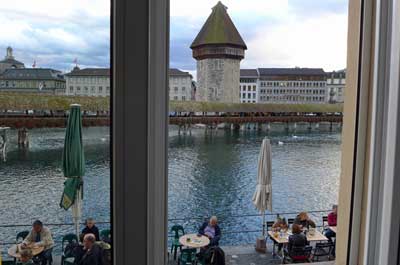
If this place is booked, which is often the case, then book a hotel as close to it as you can find or afford. The whole historic part of town surrounding it is lovely, with restaurants, bars, and high-end shops. There are also a couple of nearby supermarkets where you can buy inexpensive alcohol and picnic supplies to keep other costs down.
Spend a day in Lucerne itself
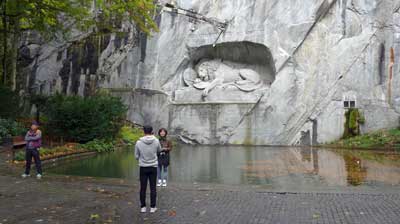
Most of the interesting part of Lucerne is in the area behind those restaurants, and it’s certainly worth doing a self-guided walking tour if not a guided one. Heading farther east you’ll come to another older part of town where the famous lion statue is located. You can’t visit Lucerne without having a look at the lion, and fortunately it’s easy and quick to reach (and it’s free).
Take a lake cruise of some kind
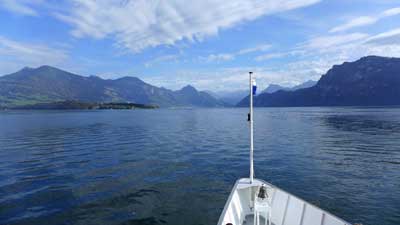
Especially in nice weather, even the short lake tour is lovely, and if you have more time you can jump off at Vitznau and do the scenic hike up Mount Rigi. There are also small lakeside villages that are ideal for a stroll and lunch stop. Long story short, there are dozens of interesting sightseeing options that are available using part of the boat tour, and the views all around are wonderful.
Visit Mount Pilatus
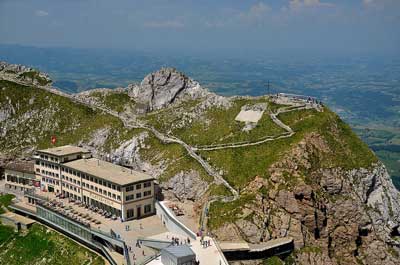
You can take the cogwheel train up and have a more or less flat hike around the summit area, and then take the gondola and cable car back down again. You can do them in the other order, and the cost is the same either way. At around US$65, this is not a cheap hike, but like most everything in Switzerland, the quality is high so it doesn’t feel like a rip-off. You can reach the cable car in 10 minutes on a public trolly bus from Lucerne.
Visit Mount Rigi
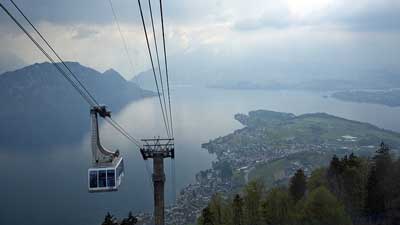
Unlike the other peaks mentioned in this article the Swiss Travel Pass covers both ways to get up and down for free. The others are 50% off with the Swiss Travel Pass or Half Fare Card, except for Jungfraujoch, which is only 25% off with the Swiss Travel Pass and still 50% off with the Half Fare Card.
Visit Mount Titlis
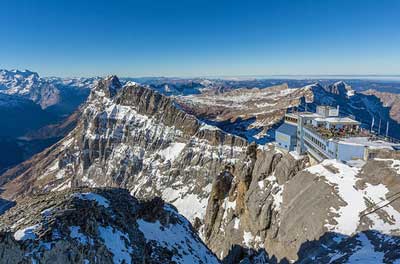
You can reach Titlis by taking a 43-minute train ride from Lucerne to Engelburg and then taking the cable car up from there. As with the others, it’s wise to check the weather immediately before you are going to depart because it can be foggy or cloudy any time of the year, but usually not for whole days at a time.
Additional photo credits
Jungfraujoch by cupweuro on Flickr, Pilatus by Tony Fernandez on Flickr, Rigi by Kosala Bandara on Flickr, Titlis by PaulSchliebs on Flickr

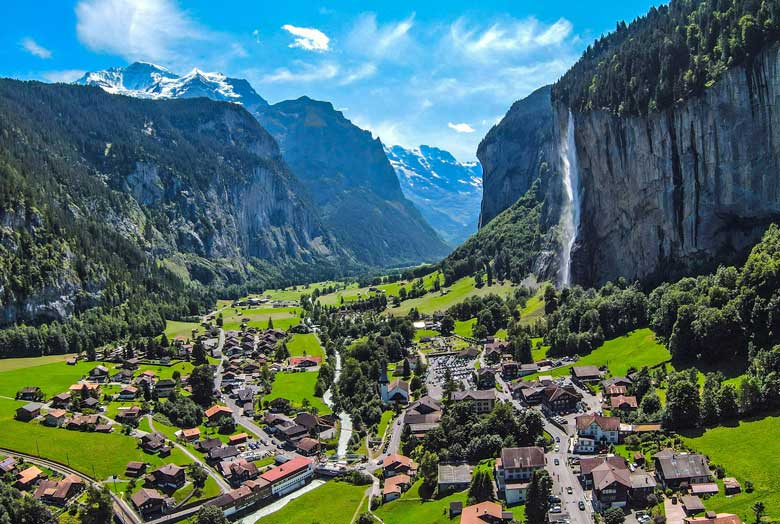
Hi Roger,
Your article was very informative, i would be visiting Switzerland with my husband and 12 yr old daughter for the first time from Singapore (26th nov 2016 to 6 th dec). We do not ski . We are more interested in sightseeing , would like to see a lot of snow ,kindly suggest the places that we can visit during 10 days, our entry and exit to switzerland would be from Geneva airport.
Thanks in advance.
Padma,
One sort of tricky thing about this is that the snow season in Switzerland can be tough to predict, depending on your altitude. There is snow all year long at the highest peaks, including up at the Jungfraujoch train station, so you can definitely spend some time in the snow while you are there. However, in the towns with hotels and tourist infrastructure such as Murren, Gimmelwald, Grindelwald, and Wengen, there might be snow in late November, or maybe not. You probably won’t know until about a week in advance.
Another good option to consider is St. Moritz, which is mostly known as a ski area, but there are many more things to do there and it’s at a higher elevation so there is greater chance of snow while you are there.
Since you have 10 days I’d recommend spending at least 4 or 5 of those days in the Interlaken area, as discussed in the article above. You could also plan some time in St. Moritz, or even Zermatt (another ski town with the Matterhorn behind it). I’d also recommend at least 2 or 3 days in the Lucerne area, which is quite different from the others. There are several nearby mountaintops that you can reach by cogwheel train or cable car, and some of those should have snow while you are there as well.
It’s a quiet time of year for tourism in Switzerland in late November, so there will be plenty of hotel vacancies. In fact, in some smaller towns like Gimmelwald, many of the hotels close from mid October to mid December. Still, it should be pretty easy to get hotel reservations with no notice, so you might want to keep your trip flexible and then just go where the snow is and where you feel like. -Roger
Hello Roger,
Thanks for the reply! I have booked the flight to Paris and hotel and exit from Zurich back to India.
I need your suggestions as to where to stay in Interlaken.
Arindam,
Very good to hear and I’m sure you’ll have a great trip. It’s hard to recommend a specific hotel in a city like Interlaken with so many of them, and without knowing your budget. But in general, I find that the most convenient location is somewhere within a short walk of the Interlaken Ost train station. Just check booking.com and find a place with good reviews that is within your price range. -Roger
Roger,
Though I have 8-9 days, I could prepare the following itinerary for only 6 days. Could you confirm if it is fine? Also suggest if I can cover more in 8 days.
Day 1 – Zurich – Head streight to Interlaken
Day 1 – Interlaken – Stay in Interlaken & roam around the city
Day 2 – Lauterbrunnen – Stay in Interlaken & travel to Lauterbrunnen-Schilthorn from here
Day 3 – Jungfraujoch – Stay in Interlaken & do Jungfraujoch from here
Day 4 – Transit – Move to Gimmelwald from Interlaken
Day 4 – Gimmelwald & Mürren – Stay in Gimmelwald and do Gimmelwald & Mürren
Day 5 – Transit – Travel to Lucerne / Luzern via Interlaken
Day 5 – Lucerne / Luzern – Stay in Lucerne / Luzern and roam around the city
Day 6 – Transit – Travel to Zurick Airport to fly back to Finland
Regards,
jags
jags,
If you are primarily interested in the scenery and specifically the scenery near Interlaken and Lucerne, then I agree that 6 day should be plenty. For one thing, your 2nd and 3rd days in the Interlaken area will be magical, but your 4th or 5th day would be less magical because it does get to look a bit similar after a while. And as mentioned in the article above, if you want to spend a day or so in one of Switzerland’s cities, then a day and night in Bern is very worthwhile.
As for your itinerary here, it looks pretty good, but you can actually combine a few of these things and free up more time. Specifically, the Schilthorn observation deck takes about an hour to reach from the valley floor near Lauterbrunnen, on a series of cable cars. If the weather at the top is clear in the morning, you could take the cable cars up there and spend maybe an hour or so (there is an included James Bond attraction in the basement of the structure, and it’s worth a look, but after 90 minutes up there you’ll be more than ready to go back down).
On your way down the cable cars, the second to last stop before the bottom is Murren. You could get off there and spend an hour or two walking around the town, and then another 30 minutes walking down to Gimmelwald, which is the next stop down on the cable car. It’s a really lovely walk and I’d recommend it for everyone if the weather is decent. Once you reach Gimmelwald, you can literally walk the entire town in 10 minutes or less. At that point you could climb on the cable car and in 5 minutes (departures every 30 minutes) you are back on the valley floor.
Now, I’m one of many people who highly recommends spending a night or two in Gimmelwald or Murren because it’s just such a stunning place to wake up and hike around a bit. Gimmelwald in particular is this tiny village of farms and a few hotels and guesthouses, with no roads or cars (although some farmers do have little carts that drive along the main path as they work). It’s this heavenly and gorgeous place to stay that you’ll never forget. But again, it’s better if the weather is clear, which isn’t always the case.
So with that in mind, you could combine Schilthorn and Murren and Gimmelwald into no more than 36 hours, or perhaps 48 hours altogether. That said, there are dozens of other scenic hikes and places to visit in and around the Interlaken area, not to mention all of the adventure activities on offer. You can and should use the rest of the time in that area to visit a few more places and do a few scenic hikes. Once you research it a bit, you’ll find endless options.
I think one day in Lucerne is very worthwhile and should be enjoyable as well. You might even do two days if you have the time. The city itself is really lovely, and the key activity there is to take the boat out on the lake that stops in all of the local villages before coming back to Lucerne. You can get off at any of them, and walk around those little towns and do some other hikes and whatnot, and then get on the next boat coming by like a ferry. Mount Rigi is reached from one of those stops.
And the last thing to mention when discussing Switzerland is that some things are shockingly expensive. Coming from Finland it might not be as shocking for you as for many other people, but still Switzerland is not a place to try to visit on a typical backpacker budget.
Let me know if you have any other questions, and I’m sure you’ll love it. -Roger
Hello again…
I will be arriving in Zurich on Monday at 1:40pm and will be staying in Murren for two days and then heading back to Zurich to Berlin…I have a carry on and one large suitcase 🙁 Will I be able to take that on the cable car up to the Hotel in Murren? I have looked at some of the door to door luggage services and thought I could register 48 hours in advance but have learned it needed to be 7 days in advance…any suggestions?
Mary,
The cable cars going up to Murren (and further to Schilthorn) are simply empty boxes with standing room for about 80 people each. They are the primary source of transport for all the tourists and most of the residents of the area, so they are often used for carrying cargo of all kinds. In other words, you’ll have no problem boarding with your suitcases, and having them sit at your feet. The first leg is only 5 minutes up to Gimmelwald, and then you walk 5 meters across the platform to the next cable car waiting for you, which leaves for Murren after everyone is on board.
Even the free bus that takes you from the Lauterbrunnen train station to the cable car station in Stechelberg has plenty of space for luggage, as it’s also used to carry cargo for locals and all belongings of visitors. It’s a lot easier than you might think once you get there. Have a great trip. -Roger
Thank you so much…you have put my mind at ease!
Mary
Hello Roger, First of all r right article just what I needed to get started! I am from India and I am planning a Honeymoon trip from 12-17 August 2016 in Europe. I am planing to cover Paris and Switzerland only. I need your advice in deciding as to how many days I should spend at each location and which location to visit in Switzerland as I am tight on time & budget both.
Many Thanks!
Arindam,
Always happy to help. It’s a shame you don’t have 6 days for this trip, but if you only have 5 I’d do 3 nights in Paris and 2 nights in the Interlaken area. Have a close look at the article above, and you’ll see my suggestion for staying in Gimmelwald or Murren, which will give you the most amazing Switzerland Alps experience in the shortest time. If you require vegetarian food, it’s probably easy to get that in Murren compared to Gimmelwald, which is tiny with only a few restaurants. But even if you stay in Murren, have a walk down the path to Gimmelwald while you are there.
The city of Interlaken is quite popular with Indian tourists, so you’ll find a wide selection of veg and other familiar options there. The same is true in Paris, of course.
Especially on a honeymoon (congrats, by the way), Paris is not a place you want to rush through. Even with only 2 full days (and 2 partial days), it will be tough to see even half of the wonderful and romantic things there. Fortunately, the best part of Switzerland in the Interlaken area is quite compact, so in two days there you’ll feel like you’ve seen what you’ve come for. Have a great trip, and let me know if you have any other questions. -Roger
HI – I really enjoyed this information. My adult son and I are starting to plan a trip to Europe in 2018, spending 3 days in Switzerland. My plan is to fly in from Vienna to Zurich and then take the train to Interlaken. I’m thinking of making Interlaken our base and then taking the trip by train further to Schilthorn for a day trip. We are planning on May – what do you think?
Debbie D,
Happy to hear that. Yes, that plan sounds ideal. However, as I’ve mentioned quite a few times, I highly recommend spending 1 or 2 nights in Gimmelwald, or in Murren, as mentioned in the article above. Both of those towns (Gimmelwald is really a tiny village) are part of the way up the cable car that goes to Schilthorn, so it’s actually slightly cheaper to start from there. Also, Schilthorn can be moody with cloud cover and such, so it’s best to have a look at the weather on top just before you go, and then head up quickly when it’s sunny. From Gimmelwald you are less than an hour from the top, while from Interlaken itself it takes about 2 hours.
The weather in May should be almost perfect, but still chilly up in the mountains. You can stay the other 1 or 2 nights in Interlaken itself, near one of the train stations, and that will give you the ability to get anywhere else in the region quickly. Let me know if you have any other questions. -Roger
Hello Roger,
Thank you for the all the information which is really helpful.
I’m planning to visit only interlaken for 5 days in August and wanted to seek your advice on the below please:
– Do you think 5 days is quite too much to spend in Interlaken only keeping in mind I will do hiking twice during the trip (each time on a separate day)?. Unwinding and hiking are actually my main objectives of the trip and I would like to avoid the cities atmosphere.
– I will be arriving Zurich in the evening by probably 8:00 p.m. In this case, do you still suggest I go to Interlaken by train or probably by car since I will miss all the scenery on my way to Interlaken?
– I will be travelling by myself. Do you suggest I get myself a private tour guide? If yes, what tour guides do you recommend?
What other activities do you recommend in Interlaken?
Many thanks.
Aida,
Interlaken is packed with sights and activities and hikes, and it’s also very relaxing, so I think 5 days there sounds wonderful. I think the reason that most people move through so quickly is that it’s so expensive, or at least it is if you are going Jungfraujoch and Schilthorn and such. Those are both great, by the way.
Arriving in Zurich near sunset is indeed a bit tricky. The hotels there are so expensive that I wouldn’t recommend staying there just because you would miss the scenery on any train ride. Seriously, a basic room in Zurich will start at around US$200/night, and that same room would be around US$120 in Interlaken. I don’t think I’d recommend renting a car for one person because it’s almost certain to cost more than the trains you’d take, which go everywhere you want to go. But if you do rent a car, at least Interlaken is a pretty good place because some of the hotels have free parking. Also, the Zurich Airport is on the main train line, so you can go straight from there to Interlaken without having to even go into Zurich.
As for the scenery from Zurich, the first half is not much to look at, and it gets really good as you get closer to Interlaken. But if you’ll be spending 5 days in Interlaken anyway, you’d have forgotten that train scenery, as the main sights are just off the charts.
My guess is that a private guide would cost a fortune there. If you can afford it, it would be enjoyable, I’m sure. But really my best recommendation is to buy the current edition of the Rick Steves Switzerland guidebook, in print or digital. He explains all of the worthwhile sights and hikes and attractions in a concise manner. If you follow his advice, you’ll have an excellent trip for a relatively modest price.
Let me know if you have any other questions. -Roger
Hi Roger,
Thanks for your reply.
I’m actually not planning to stay in Zurich especially if the scenery is not worth it. My flight back home is in the afternoon so I might get a train ride to the airport if needed.
As for the private tour guide, thank you for the recommendation!
I’m just now not sure whether to be there for the last week of August or the 1st week of September since the rainy weather starts in September as I heard and which might make my hiking plan not work out.
Thanks again. You’ve been a great help.
Hi again Roger,
Would it be possible to share with me some tips on how to find a local tour guide in Interlaken, especially those who are good at hiking.
Thank you.
Aida,
I wish I could help you with this one, but I have no experience in finding local, private guides. I’d just Google “Interlaken tour guide” and I’m sure there will be many results. Good luck. -Roger
Hi Roger, We are 2 adult and a 11 yrs.Here is itinerary should we get swiss pass or half pass Please advise. 13 July train from Paris to Basel and on to Murren maybe go to Almendhubeghts 14 July start early Schilthorn – Stechelberg Falls – Trummelbach Falls – Lauterbrunnen valley – Staubach Falls- Wengen – Mannlichen – Kleine Scheidegg – Mürren on 15th July train to Ballenberg Museum and on to Lucern Gletschergarten Museum. 16 July start early Swiss Museum of Transport Boat to Vitznau – Rigi Kulm – Rigi Kaltbad – Weggis – Lucerne on 17th July train to Geneva. Is this doable. Please suggest.
Hamid,
Your trip looks really well planned out, but also quite busy. I think you could probably do all of that, though you might be rushing around a bit to do it. It’s hard to say whether it’s worth keeping up such a good pace to see it all, and I guess it depends on the traveler.
As for the Swiss Pass, I find them very confusing myself, and also quite expensive. My general hunch is that they are not good value for most people, unless you are really planning on traveling a lot and seeing many museums and such in a short time. However, it looks like you are planning exactly that, so it could be good value.
I’m not sure if you’ve scanned the comments above, but I seem to get this Swiss Pass question a lot, and so far I haven’t had a good answer. I think I now have to spend a few hours researching this and writing a proper article running the numbers so I can make confident recommendations. I should be able to do that within a week or so, and I’ll link that article to this one. Sorry I couldn’t give you a more conclusive answer just yet. -Roger
Thanks Roger.
You are right my plan is too tight I will play by ear and skip some places. (Any suggestion what we should skip ).
Regarding the Swiss pass its so confusing that i did the spreadsheet for both Swiss pass and half pass but still confused because lot of places i am not sure if its covered for discount and seems everyone else has the same issue. Maybe i will just get half pass for now to get 11 yrs old free.
Hamid
Hamid,
I’ve been to most, but not all of the places on your list, and you’ll have time to see many of them for sure. For example, Stechelberg Falls can be seen clearly while on the short bus ride from the Lauterbrunnen train station to the bottom of the cable car up to Schilthorn. If you look out the right side of the bus, you’ll get a good look and can probably take a decent photo. And Wengen is a nice little town that you can see as you get off the train in one area and walk through town to the cable car stop that takes you up the mountain there for excellent scenery and hiking.
So really, I’d just focus on the big things like Schilthorn and/or Jungfraujoch, and you’ll end up seeing many of the smaller things on the way without even really trying. You’ll love it. -Roger
Thanks Roger. you are the greatest.
We all will anxiously wait for your write up on a proper article in details about Swiss pass in coming week to make proper decision. Thanks again.
Hamid
Hi Roger! Thanks so much for this article – it really helped narrow down our trip to Switzerland. I will be travelling there with my wife on our honeymoon at the beginning of September, and wanted to get some insight on our drafted itinerary.
Right now, it looks like this:
Day 1: Fly into Zurich (arrive 9:30AM), head straight to Lucerne
Day 2: Lucerne
Day 3: Head to Interlaken (do Lauterbrunnen-Schilthorn from here)
Day 4: Day trip to Gimmelwald from Interlaken
Day 5: Day trip to Murren from Interlaken
Day 6: Head to Bern to stay for 1 night
Day 7: Leave Bern to Geneva Airport to fly out
Do you think the above itinerary would be a good idea? Right now we are using Interlaken as our base to go to Schilthorn, Gimmelwald, and Murren. Should we instead use Murren as a base?
I’m also wondering if we should keep the 2 nights in Lucerne, or do 1 night and spend the 2nd somewhere else.
We are a young active couple and are hoping to keep ourselves entertained from day until night (keep it lively and not get bored).
Thank you!
Harvey,
I’m always happy to hear that this helps. I think your itinerary looks quite good, although I do have a suggestion or two. Gimmelwald is a tiny village that literally consists of about 40 farms, 10 guesthouses, and a couple of shops so tiny that no one works in them (they are “honor stores” where you take what you want and leave the money). The path that runs through town is about 300 meters and then doubles back up the hill a bit for about 300 meters in the other direction. So you can literally tour the entire village in under 30 minutes. Still, it’s an amazing place to spend at least one night because that’s all there is to it, aside from some of the finest mountain views in the world.
Murren is literally 50 times larger, but it’s also very quaint and car-free. It has dozens of guesthouses and hotels, and a proper little downtown, as well as ski lifts (there won’t be snow at that altitude in September though). If you want to see both towns you can take the cable car up from Lauterbrunnen up two stops and you’ll be in Murren. You can walk around there for an hour or two, and then walk down the path about 15 minutes and it goes straight through Gimmelwald, where you can take the cable car back down one stop to the valley floor. So again, I’d recommend at least one night in one of those towns, but if you just want to see them, you can do both in a few hours. And Schilthorn is at the top of that series of cable cars, so it’s best to actually take the cable car all the way to the top and spend an hour or two there, and then take the cable car a couple stops back down to Murren, and then walk to Gimmelwald for the ride back down (or stay the night there).
There are also many other excellent sights and hikes and such in that area, and the weather in September should be nice enough to enjoy any of them. Lucerne is really nice, but I do think that one night there should be enough if you can spend 3 nights in the Interlaken area. As long as you do some research of the various scenery and attraction options, you’ll love it and won’t get bored. I highly suggest getting Rick Steves’ Switzerland guide, as he describes all of this and the best options in great detail. It’ll be the best US$10 or US$20 you spend on this trip. It also gives you the best suggestions for Lucerne and Bern as well.
Let me know if you have any other questions. -Roger
Thanks Roger for elaborated information.
I am bit confuse in choosing my base. Should I keep my base at Interlaken or Lauterbrunnen? Also, I just wanted to highlight that I am travelling my with son. I hope, there would not be any challenge in taking his pram / stroller everywhere during the trip.
jags,
For the nights that I wasn’t up in Gimmelwald or Murren, I’d base myself in Interlaken. Lauterbrunnen is a small town that happens to be the transit hub of many sights in that area, but there isn’t much there really. Also, Lauterbrunnen is only a 15-minute train ride from the Interlaken Ost (east) train station, leaving every 30 minutes. The other decision will be where to stay in Interlaken. There are clusters of hotels near both train stations, and the West station has more hotels and restaurants and such, but the Ost station is the one where the Lauterbrunnen train leaves from. Fortunately, if you are staying at any hotel or hostel in Interlaken, you automatically get a card good for free public transport in the city, and that includes rides between the two train stations. And all trains stop at both stations, so you can get on any train going in your direction and it will stop at the other one. I stayed near the West station, and liked that area and the more food options. And the most historic part of the town is close to the West station as well.
Switzerland is extremely professional and well organized with its trains and buses and everything else, so I think you’ll always be fine with the pram, and that includes the cable cars. Have a great trip. -Roger
Hi Roger, I am visiting Paris in December 2016 during Christmas on visitor’s visa. I am staying in my friends place for about 7-8 days. I would like to travel near by neighboring countries to Paris. My first preference is Switzerland.I do have max 2 days plan to Switzerland, Which would be the best places for me to go that includes skying, cable car, covering exotic places.
Sandesh,
At the risk of sounding like a broken record in these comments, if you have two days in Switzerland and want to see the most dramatic scenery all in one place, you should head to the Interlaken area (as described in the article above). Take the cable car in Lauterbrunnen up to Gimmelwald for the scenery, or one stop higher into the town of Murren, which has a large and reliable ski resort with 13 lifts right in its center.
The train from Paris to Interlaken Ost train station is 5 hours and 5 minutes, and the scenery once you get into Switzerland is incredible. Let me know if you have any other questions. -Roger